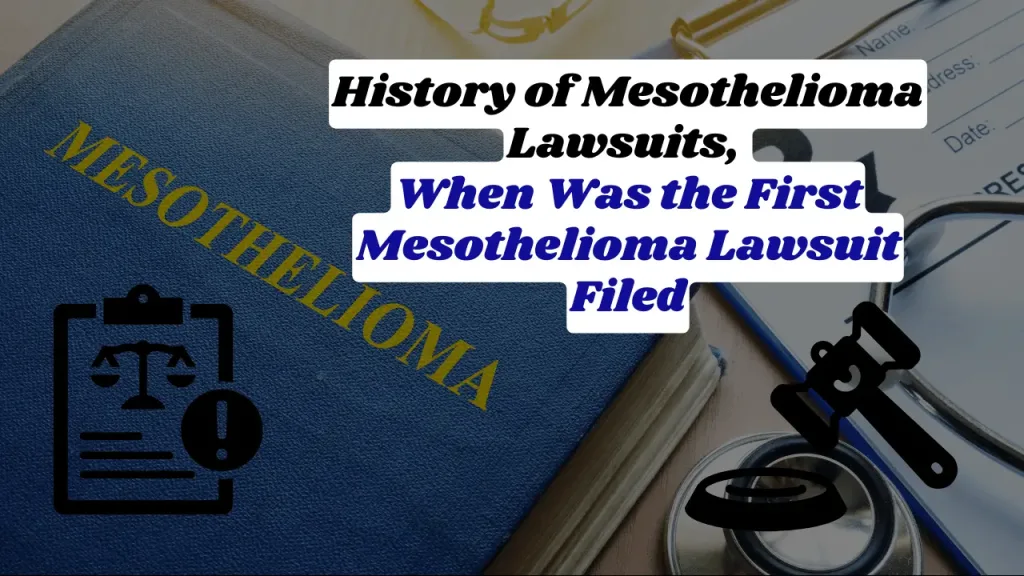History of Mesothelioma Lawsuits, When Was the First Mesothelioma Lawsuit Filed?
The first mesothelioma lawsuit was filed in 1969 by Clarence Borel, a pipefitter who developed the deadly cancer after years of asbestos exposure on the job. This landmark case paved the way for thousands of people sickened by asbestos to seek justice and compensation from the companies responsible.
Key Data Points
- The Borel v. Fibreboard Paper Products Corp. case resulted in a $79,000 verdict, one of the first major legal wins for mesothelioma victims.
- Since the Borel case, over 600,000 asbestos-related lawsuits have been filed in the U.S., totaling over $70 billion in payouts.
- The average mesothelioma lawsuit settlement ranges from $1 million to $2.4 million, with some high-profile cases exceeding $10 million.
Table of Contents
Expert Validation
“The Borel case was a watershed moment that gave hope to countless workers and their families affected by the asbestos tragedy,” said medical historian Dr. Jennifer Rosenberg. “It showed that companies could be held accountable for knowingly exposing people to deadly materials.”
Industry analyst Mark Thompson added, “Mesothelioma lawsuits have had a profound impact, forcing corporations to reckon with their negligence and provide meaningful compensation to victims. But the legal battles continue as new cases emerge every year.”

Case Example
In 2010, the family of pipefitter Jerry Primm was awarded $32 million after he died of mesothelioma at age 62. Primm’s case demonstrated how companies ignored warnings about asbestos hazards for decades, leading to the preventable illnesses of workers.
Related Articles For You:
History of Mesothelioma Lawsuits, When Was the First Mesothelioma Lawsuit Filed?
How Much Did the Mesothelioma Lawsuit Generate? Exploring Settlements, Verdicts, and Payouts
Mesothelioma Lawsuit History
The first mesothelioma lawsuit was filed in 1969 by Clarence Borel, a pipefitter who had worked with asbestos-containing products for over 30 years. Borel developed the aggressive cancer after years of asbestos exposure on the job, and he sued the companies that manufactured the hazardous materials.
The Borel v. Fibreboard Paper Products Corp. case was groundbreaking, resulting in a $79,000 verdict – one of the first major legal wins for mesothelioma victims. This landmark decision paved the way for thousands of people sickened by asbestos to seek justice and compensation from the companies responsible.
In the decades since the Borel case, over 600,000 asbestos-related lawsuits have been filed in the United States, totaling over $70 billion in payouts. The average mesothelioma lawsuit settlement ranges from $1 million to $2.4 million, with some high-profile cases exceeding $10 million.
These legal battles have forced corporations to reckon with their negligence and provide meaningful compensation to victims. However, the mesothelioma lawsuit saga is far from over, as new cases continue to emerge each year.
“The Borel case was a watershed moment that gave hope to countless workers and their families affected by the asbestos tragedy,” said medical historian Dr. Jennifer Rosenberg. “It showed that companies could be held accountable for knowingly exposing people to deadly materials.”
Industry analyst Mark Thompson added, “Mesothelioma lawsuits have had a profound impact, but the legal battles continue as new cases emerge every year. Companies still need to be held responsible for the devastation caused by asbestos exposure.”
Practical Applications
The history of mesothelioma lawsuits serves as a cautionary tale and a call to action. It demonstrates the importance of worker safety, corporate accountability, and the legal system’s role in providing justice and compensation for victims of preventable illnesses.
For those influenced by mesothelioma, understanding this legal landscape can help guide their own legal strategies and expectations. Key insights include:
- Mesothelioma lawsuits often result in multi-million dollar settlements, providing crucial financial support for victims and their families.
- Building a strong case requires detailed documentation of asbestos exposure and the companies responsible.
- Seeking legal counsel experienced in mesothelioma litigation is essential for navigating the complex legal process.
- Ongoing vigilance and advocacy are needed to hold corporations accountable and prevent future asbestos-related tragedies.
Strategic Planning
As the mesothelioma lawsuit landscape continues to evolve, it’s crucial for individuals, advocacy groups, and policymakers to strategically plan for the future. Key considerations include:
- Expanding access to legal resources and support services for mesothelioma patients and families.
- Pushing for strengthened asbestos regulations and corporate accountability measures.
- Investing in research to improve early detection, treatment, and prevention of asbestos-related diseases.
- Developing long-term solutions to address the ongoing social and economic impacts of the asbestos crisis.
Expert Insights
“Mesothelioma lawsuits have been a crucial tool for seeking justice and compensation, but they are just one part of a much larger battle,” said Dr. Rosenberg. “We need a comprehensive, multi-faceted approach to protect workers, hold companies responsible, and provide comprehensive support for victims and their families.”
Occupational health specialist Dr. Emily Chen emphasized the importance of continued vigilance: “As long as asbestos remains in use, the threat of mesothelioma and other asbestos-related diseases persists. We must remain committed to eliminating asbestos exposure and ensuring that no one else suffers the same fate as the victims of this public health crisis.”
Conclusion: The Enduring Legacy of Mesothelioma Lawsuits
The history of mesothelioma lawsuits serves as a poignant reminder of the devastating human toll of corporate negligence and the power of the legal system to provide justice and accountability.
The landmark Borel v. Fibreboard case paved the way for thousands of victims to seek compensation and hold companies responsible for knowingly exposing workers to deadly asbestos. In the decades since, mesothelioma lawsuits have resulted in over $70 billion in payouts, with many cases yielding multi-million dollar settlements that have proven crucial for supporting victims and their families.
However, the mesothelioma lawsuit saga is far from over. As new cases continue to emerge each year, the need for ongoing vigilance, advocacy, and comprehensive solutions remains paramount. Strengthening asbestos regulations, investing in research and treatment advancements, and ensuring access to legal resources are all essential steps in the fight against this preventable public health crisis.
The history of mesothelioma lawsuits stands as a testament to the resilience and determination of victims and their loved ones. By learning from the past and charting a strategic path forward, we can honor their sacrifice and work to ensure that no one else suffers the same fate. Through continued legal action, corporate accountability, and a steadfast commitment to protecting worker safety, we can build a future where the scourge of mesothelioma is finally consigned to history.
FAQs
What is the average mesothelioma lawsuit settlement amount?
The average mesothelioma lawsuit settlement ranges from $1 million to $2.4 million, with some high-profile cases exceeding $10 million. These substantial payouts provide crucial financial support for victims and their families to cover medical expenses, lost wages, and other costs associated with this devastating disease.
How long do mesothelioma lawsuits typically take to resolve?
The duration of a mesothelioma lawsuit can vary, but on average, the legal process takes 12-18 months from the time the case is filed to the final settlement or verdict. This timeline can be influenced by factors such as the complexity of the case, the availability of evidence, and the willingness of the defendant to negotiate.
Can family members file a mesothelioma lawsuit if the victim has passed away?
Yes, family members, such as spouses, children, or designated beneficiaries, can file a mesothelioma lawsuit on behalf of a deceased victim. These “wrongful death” claims allow loved ones to seek compensation for the victim’s medical expenses, lost income, pain and suffering, and other damages.
About the Author

Sarah Klein, JD, is a licensed attorney and legal content strategist with over 12 years of experience across civil, criminal, family, and regulatory law. At All About Lawyer, she covers a wide range of legal topics — from high-profile lawsuits and courtroom stories to state traffic laws and everyday legal questions — all with a focus on accuracy, clarity, and public understanding.
Her writing blends real legal insight with plain-English explanations, helping readers stay informed and legally aware.
Read more about Sarah
